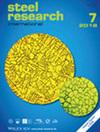Steel–Steel Laminates Manufactured via Accumulative Roll Bonding
IF 1.9
3区 材料科学
Q2 METALLURGY & METALLURGICAL ENGINEERING
引用次数: 0
Abstract
Accumulative roll bonding (ARB) is a repeated cladding process in which two or more sheets of material are joined together by rolling at temperatures below recrystallization. The present review is focused on ARB of high‐alloy steels, which, among other laminated metal composites (LMCs), deliver the highest mechanical properties. After a brief description of high‐strength steels, history, and state of the art of LMCs, the principal roll bonding mechanism is explained. Further, the methodology of ARB of steels and variable parameters (stacking, temperature, etc.) are discussed. Known examples of steel–steel laminates are summarized with respect to their rolling temperature and mechanical properties. Further, the main toughening mechanisms of steel‐based LMCs are listed. The most promising candidates of high‐alloy steel laminates are presented in more detail. The important deformation mechanisms of twinning‐ and transformation‐induced plasticity (TWIP and TRIP) high‐alloy steels are explained. Microstructural changes and layer bonding as well as mechanical properties and damage behavior of two‐ and four‐layered TRIP/TWIP steel laminates are illustrated, including some specific phenomena, such as deformation lenses. Finally, by summarizing the analyzed data on steel laminates, conclusions and outlook are formulated.通过累积轧制粘合制造的钢-钢层压板
累积轧制粘接(ARB)是一种重复堆焊工艺,在低于再结晶的温度下,通过轧制将两片或多片材料连接在一起。本综述侧重于高合金钢的 ARB,在其他层压金属复合材料(LMC)中,高合金钢具有最高的机械性能。在简要介绍了高强度钢、历史和 LMC 技术现状之后,对主要的轧辊粘接机制进行了说明。此外,还讨论了钢的 ARB 方法和可变参数(堆叠、温度等)。根据轧制温度和机械性能总结了已知的钢-钢层压板实例。此外,还列出了钢基 LMC 的主要增韧机制。更详细地介绍了最有前途的候选高合金钢层压板。解释了孪晶和转变诱导塑性(TWIP 和 TRIP)高合金钢的重要变形机制。说明了双层和四层 TRIP/TWIP 钢层压板的微观结构变化、层结合以及机械性能和损伤行为,包括一些特殊现象,如变形透镜。最后,通过总结钢层压板的分析数据,提出了结论和展望。
本文章由计算机程序翻译,如有差异,请以英文原文为准。
求助全文
约1分钟内获得全文
求助全文
来源期刊

steel research international
工程技术-冶金工程
CiteScore
3.30
自引率
18.20%
发文量
319
审稿时长
1.9 months
期刊介绍:
steel research international is a journal providing a forum for the publication of high-quality manuscripts in areas ranging from process metallurgy and metal forming to materials engineering as well as process control and testing. The emphasis is on steel and on materials involved in steelmaking and the processing of steel, such as refractories and slags.
steel research international welcomes manuscripts describing basic scientific research as well as industrial research. The journal received a further increased, record-high Impact Factor of 1.522 (2018 Journal Impact Factor, Journal Citation Reports (Clarivate Analytics, 2019)).
The journal was formerly well known as "Archiv für das Eisenhüttenwesen" and "steel research"; with effect from January 1, 2006, the former "Scandinavian Journal of Metallurgy" merged with Steel Research International.
Hot Topics:
-Steels for Automotive Applications
-High-strength Steels
-Sustainable steelmaking
-Interstitially Alloyed Steels
-Electromagnetic Processing of Metals
-High Speed Forming
 求助内容:
求助内容: 应助结果提醒方式:
应助结果提醒方式:


